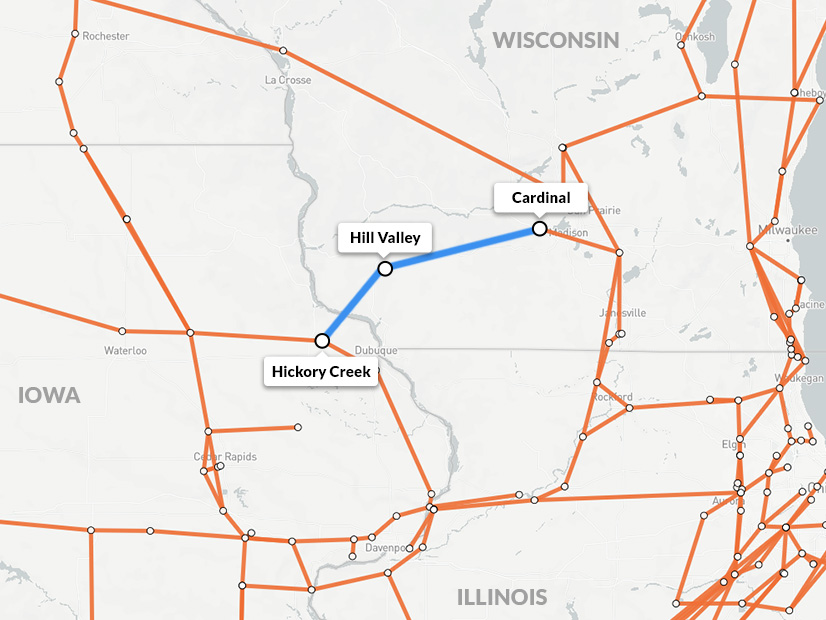Thirteen years after it was recommended by MISO, the controversial 102-mile, $655 million Cardinal-Hickory Creek line is completely in service.
Co-owners ITC Midwest, American Transmission Co. and Dairyland Power Cooperative announced the completed 345-kV line was flowing power between the Hickory Creek Substation in Dubuque County, Iowa, and the Cardinal Substation in Middleton, Wis., as of Sept. 26. The developers originally anticipated a June 28 full in-service date. The eastern half of the line was energized months ahead of the western half in December 2023 as court battles played out.
Cardinal-Hickory Creek was approved in 2011 as part of MISO’s multivalue project portfolio and earned a reputation as the most contentious of the 17-line collection. The line’s construction pitted usual environmental bedfellows — conservationists and renewable energy developers — against one another because the line crossed through the Upper Mississippi River Wildlife and Fish Refuge. For years, conservation groups — the National Wildlife Refuge Association, Driftless Area Land Conservancy and Wisconsin Wildlife Federation — argued that the river crossing would scar and fragment wildlife habitat and ruin floodplains.
Cardinal-Hickory Creek’s final mile intersecting the refuge was tied up in litigation for months this year as the conservation groups lodged a final lawsuit to halt an ultimately successful land swap between the utilities and the U.S. Fish and Wildlife Service that traded more than 35 acres in Wisconsin for almost 20 acres of the refuge’s Iowa footprint. (See Cardinal-Hickory Creek Developers Appeal Injunction on Line’s Final Mile.)
The trio of environmental groups argued that the U.S. Fish and Wildlife Service, U.S. Rural Utilities Service and U.S. Army Corps of Engineers violated federal laws when they approved permits and accepted the land exchange.
In May, the Seventh U.S. Circuit Court of Appeals lifted a Wisconsin federal judge’s preliminary injunction issued in March, clearing the way for the final, mile-long connection. The three-judge panel said the federal judge lacked justification for his decision to grant the injunction. Conservation groups tried for a stay; Environmental Law and Policy Center Executive Director Howard Learner, representing the conservation groups, argued the refuge “should not be bulldozed before the conservation groups receive their long-delayed fair day in court.”
Dairyland Power Cooperative CEO Brent Ridge characterized line completion as a “victory for energy consumers and the environment.”
“As a backbone interconnection, the line will finally serve as the vital link to a long waiting list of regional renewable energy projects. While supporting carbon reduction goals, Cardinal-Hickory Creek also strengthens grid reliability and resilience at a time of great change in the energy industry,” Ridge said in a press release.
“Following years of work, including numerous opportunities for public input, extensive regulatory and environmental review, and construction, the entire Cardinal-Hickory Creek line has been placed in service. This allows the project to begin providing numerous economic benefits for electric consumers and environmental benefits for the entire region,” ITC Midwest President Dusky Terry added. Terry thanked construction crews in particular for building the line “in full compliance with comprehensive environmental standards.”
ATC Senior Vice President of Construction and Maintenance Jared Winters said Cardinal-Hickory Creek will improve reliability, allow access to lower cost energy and offer interconnection points for new renewable resources.
ITC estimates that 160 renewable generation projects representing more than 24.5 GW in Wisconsin, Iowa and other parts of the Upper Midwestern states were dependent on the line’s completion.
The developers said they minimized environmental impacts of construction as much as possible, consulting with federal agencies. They said they used wooden construction mats to reduce soil disturbance and sedimentation, did not perform any grading within the refuge and have restored or will restore any impacted natural areas.
Clean Grid Alliance also cheered the announcement and said the line was subjected to “unsuccessful and unnecessary” legal challenges.
“Finally! We can now celebrate the ability to deliver more than 24,000 megawatts of clean, affordable, reliable energy, plus the added benefit of improved grid reliability, all of which is now possible because the Cardinal-Hickory Creek transmission line has been energized,” Clean Grid Alliance Executive Director Beth Soholt said in a press release.
Even with the line’s energization, the National Wildlife Refuge Association, Driftless Area Land Conservancy and Wisconsin Wildlife Federation remain hopeful in their lawsuit.
Wendy Bloom, senior attorney at the Environmental Law and Policy Center, said a federal court has never found the crossing through the refuge legal. She said the conservation groups maintain ITC, ATC and Dairyland acted unlawfully by clearing protected refuge land after striking the land exchange.
“Despite today’s news, we are still awaiting an important decision in our lawsuit in federal court. We are proud to have worked with so many in our community and other committed organizations to oppose construction of this unnecessary line,” Jennifer Filipiak, executive director of the Driftless Area Land Conservancy, said in a statement.
The groups also said the east-west transmission line bisects a north-south migratory bird flyway used by hundreds of thousands of birds annually.
Since its multivalue portfolio, MISO has designed two more long-term transmission portfolios: the first, $10 billion long-range transmission plan (LRTP) was approved in 2022, and MISO is advancing a second, nearly $22 billion LRTP package for board approval at the end of the year. (See MISO Affirms Commitment to $21.8B Long-range Tx Plan in Final Workshops.)
The second LRTP portfolio calls for a 765-kV line crossing the Mississippi River from Wisconsin’s Driftless Area into Minnesota, which has led some members to call on MISO to keep the contested Cardinal-Hickory Creek in mind and carefully examine routing assumptions through protected areas. (See “LRTP Mississippi Crossing Raises Specter of Cardinal-Hickory Creek,” MISO Vouches for 2nd, $25B Long-range Tx Portfolio.)



